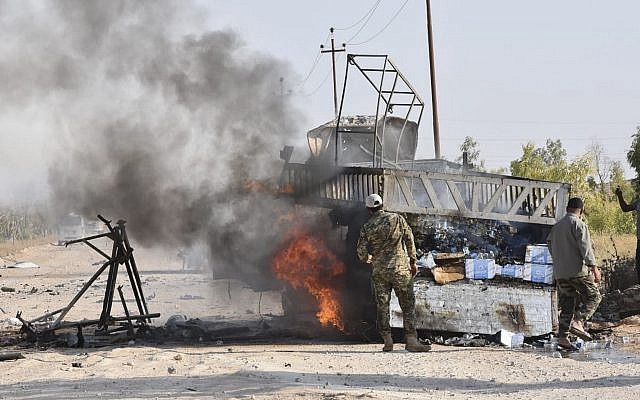Iranian-backed Popular Mobilization Forces personnal stand by a burning truck after a drone attack, blamed on Israel, in western Iraq near the Syria border, August 25, 2019 (AP)
Satellite images indicate that an Iranian base in eastern Syria was badly damaged by airstrikes on March 11.
The attacks were on the Imam Ali base in al-Bukamal on the Iraqi border, hours after Iranian-supported militias killed two American troops and a British medic in a rocket attack on Camp Taji inside Iraq.
Unconfirmed reports claim 26 pro-Assad troops, including Iranian-led militiamen, were slain in the retaliation. The satellite images, highlighted by Seth Frantzman of the Jerusalem Post, show 15 buildings damaged or destroyed.
The US military denied responsibility. The Israel Defense Forces, who have regularly struck Iranian positions during Syria’s 9-year conflict, do not comment on their operations.
The US military officially said that it responded on March 13 with missile attacks on militia warehouses in Iraq.
The Imam Ali base has been attacked and rebuilt several times. Israel is suspected of strikes in June 2018 and from July to September 2019, as Iran was reconstructing the position.
The base was also stuck on January 9, a day after the calibrated Iranian operations against American forces in Iraq. Israel was again suspected of carrying out the attack.
See also Syria Daily, Jan 10: Israel Strikes Iranian-Backed Militia in East, Kills 8 — Reports
Syria Daily, Sept 28: Another Strike on Iran-Backed Militia Inside Iraq Near Border
Israel’s periodic attacks initially focused on Iranian transfers of weapons and missiles to Hezbollah and on the movement of Iranian and Hezbollah personnel to southwest Syria near the Israeli-occupied Golan Heights. The operations expanded across the country from 2017 as Prime Minister Benjamin Netanyahu demanded complete Iranian military withdrawal.
Since then, the Israeli forces have been focusing on Iranian bases and personnel, repeatedly hitting targets near Damascus and in central and northwest Syria.
Another Phase of Confrontation?
On December 29, the US military targeted two Syrian positions of the Iranian-led Kata’ib Hezbollah militia, as well as three inside Iraq.
Five days later, a US drone strike outside Baghdad International Airport killed Maj. Gen. Qassem Soleimani, the head of Iran’s elite Quds Force, and Abu Mahdi al-Muhandis, the Kata’ib Hezbollah leader.
War was threatened by both sides, with the Imam Ali base hit on January 5. Iran struck two Iraqi bases with American forces on January 8; however, the calibration to avoid fatalities — if not scores of US troops suffering “traumatic brain injury” — allowed Donald Trump to declare that Tehran had backed away from confrontation.
New York Times journalists, citing more than two dozen sources, report a split within the Trump Administration on whether to step up attacks on Iranian-backed positions in Iraq.
Last week, even as the Administration was finally declaring Coronavirus a “national emergency”, Secretary of State Mike Pompeo and National Security Advisor Robert O’Brien called for widespread operations in response to another rocket attack by Kata’ib Hezbollah, killing two US troops at a base north of Baghdad.
Pompeo and O’Brien said that the Iran’s leaders, facing a coronavirus crisis that has officially more than 1,500 Iranians, would be forced into negotiations accepting Administration demands.
Defense Secretary Mark Esper and Gen. Mark Milley, the chairman of the Joint Chiefs of Staff, opposed the escalation. They said there was no clear evidence that Iran ordered the attacks, and they warned of a wider conflict in the region.
Their view prevailed, as the US retaliation was limited to the strikes on the weapons depots of the Iraqi militia.

